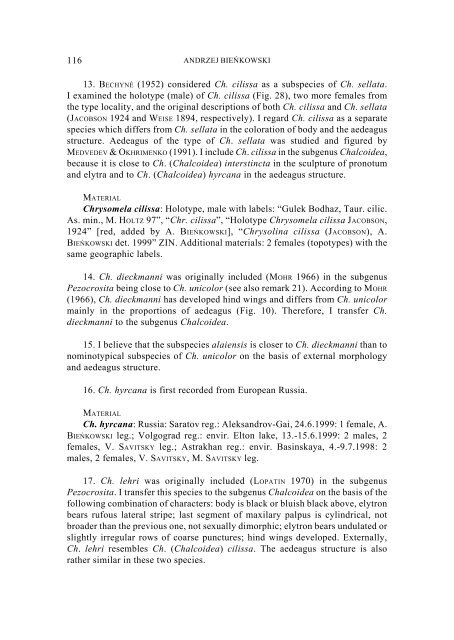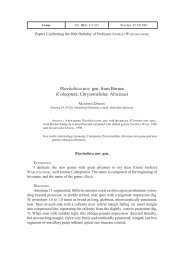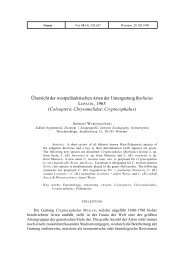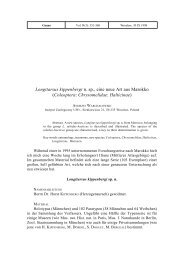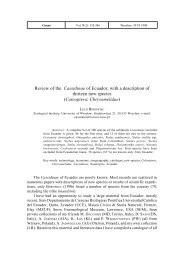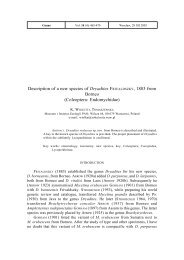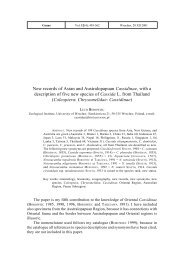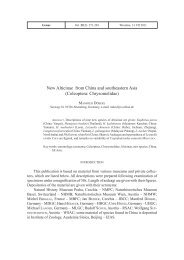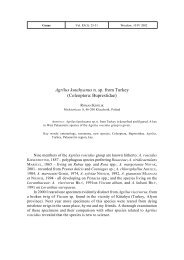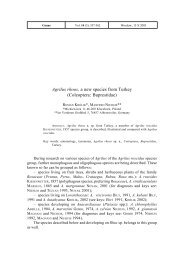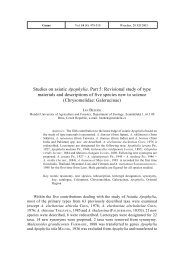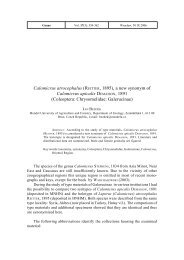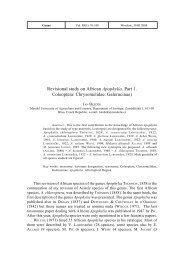A study on the genus Chrysolina MOTSCHULSKY, 1860, with a ...
A study on the genus Chrysolina MOTSCHULSKY, 1860, with a ...
A study on the genus Chrysolina MOTSCHULSKY, 1860, with a ...
You also want an ePaper? Increase the reach of your titles
YUMPU automatically turns print PDFs into web optimized ePapers that Google loves.
116 ANDRZEJ BIEÑKOWSKI<br />
13. BECHYNÉ (1952) c<strong>on</strong>sidered Ch. cilissa as a subspecies of Ch. sellata.<br />
I examined <strong>the</strong> holotype (male) of Ch. cilissa (Fig. 28), two more females from<br />
<strong>the</strong> type locality, and <strong>the</strong> original descripti<strong>on</strong>s of both Ch. cilissa and Ch. sellata<br />
(JACOBSON 1924 and WEISE 1894, respectively). I regard Ch. cilissa as a separate<br />
species which differs from Ch. sellata in <strong>the</strong> colorati<strong>on</strong> of body and <strong>the</strong> aedeagus<br />
structure. Aedeagus of <strong>the</strong> type of Ch. sellata was studied and figured by<br />
MEDVEDEV & OKHRIMENKO (1991). I include Ch. cilissa in <strong>the</strong> sub<strong>genus</strong> Chalcoidea,<br />
because it is close to Ch. (Chalcoidea) interstincta in <strong>the</strong> sculpture of pr<strong>on</strong>otum<br />
and elytra and to Ch. (Chalcoidea) hyrcana in <strong>the</strong> aedeagus structure.<br />
MATERIAL<br />
Chrysomela cilissa: Holotype, male <strong>with</strong> labels: “Gulek Bodhaz, Taur. cilic.<br />
As. min., M. HOLTZ 97”, “Chr. cilissa”, “Holotype Chrysomela cilissa JACOBSON,<br />
1924” [red, added by A. BIEÑKOWSKI], “<strong>Chrysolina</strong> cilissa (JACOBSON), A.<br />
BIEÑKOWSKI det. 1999” ZIN. Additi<strong>on</strong>al materials: 2 females (topotypes) <strong>with</strong> <strong>the</strong><br />
same geographic labels.<br />
14. Ch. dieckmanni was originally included (MOHR 1966) in <strong>the</strong> sub<strong>genus</strong><br />
Pezocrosita being close to Ch. unicolor (see also remark 21). According to MOHR<br />
(1966), Ch. dieckmanni has developed hind wings and differs from Ch. unicolor<br />
mainly in <strong>the</strong> proporti<strong>on</strong>s of aedeagus (Fig. 10). Therefore, I transfer Ch.<br />
dieckmanni to <strong>the</strong> sub<strong>genus</strong> Chalcoidea.<br />
15. I believe that <strong>the</strong> subspecies alaiensis is closer to Ch. dieckmanni than to<br />
nominotypical subspecies of Ch. unicolor <strong>on</strong> <strong>the</strong> basis of external morphology<br />
and aedeagus structure.<br />
16. Ch. hyrcana is first recorded from European Russia.<br />
MATERIAL<br />
Ch. hyrcana: Russia: Saratov reg.: Aleksandrov-Gai, 24.6.1999: 1 female, A.<br />
BIEÑKOWSKI leg.; Volgograd reg.: envir. Elt<strong>on</strong> lake, 13.-15.6.1999: 2 males, 2<br />
females, V. SAVITSKY leg.; Astrakhan reg.: envir. Basinskaya, 4.-9.7.1998: 2<br />
males, 2 females, V. SAVITSKY, M. SAVITSKY leg.<br />
17. Ch. lehri was originally included (LOPATIN 1970) in <strong>the</strong> sub<strong>genus</strong><br />
Pezocrosita. I transfer this species to <strong>the</strong> sub<strong>genus</strong> Chalcoidea <strong>on</strong> <strong>the</strong> basis of <strong>the</strong><br />
following combinati<strong>on</strong> of characters: body is black or bluish black above, elytr<strong>on</strong><br />
bears rufous lateral stripe; last segment of maxilary palpus is cylindrical, not<br />
broader than <strong>the</strong> previous <strong>on</strong>e, not sexually dimorphic; elytr<strong>on</strong> bears undulated or<br />
slightly irregular rows of coarse punctures; hind wings developed. Externally,<br />
Ch. lehri resembles Ch. (Chalcoidea) cilissa. The aedeagus structure is also<br />
ra<strong>the</strong>r similar in <strong>the</strong>se two species.


